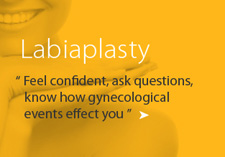When is the last time you really talked about your genital health?
Gynecological and sexual health is often hard to discuss, even though most women simply want to be healthy and informed about this aspect of their life.
Ask about Gyne /OB.
Hysteroscopic resection of Fibroids
What is a hysteroscopc resection?
- A hysteroscopic resection of fibroids is a way of removing fibroids in the uterus, without major surgery or needing a general anaesthetic.
- Please first read the information on this website about "Hysteroscopyic".
- We use a small camera that is placed on the end of a long thin tube (hysteroscope). This is gently placed into the vagina and then into the cervix opening into the uterus (womb). (SeeHysteroscopy)
- We look inside the uterus and see any fibroids, polyps or other abnormal areas.
- A fibroid or polyp can be easily removed through the narrow Hysteroscope.
- We use a special electrical loop (like a tiny cheese slicer) to remove the fibroid in small pieces.
- We stop any bleeding at the same time using cautery (special electrical surgery)
- Removing the lining (endometrium) can be done at the same time. This is called Endometrial Ablation, which makes periods very much lighter.

- This is a simple procedure with a short recovery time - you will usually go home one hour after the procedure.
What is a fibroid?
- The uterus (womb) wall is made up of special muscle.
- Sometimes, a ball of muscle forms which grows in a few directions.
- About 45% of women have at least one small fibroid in the uterus muscle layer.
- If the ball of muscle(fibroid) grows towards the inside of the uterus cavity, it is called a submucosal fibroid.(inside the cavity)
- This can sometimes interfere with a pregnancy causing a miscarriage.
- Often, these fibroids cause heavy periods.
Who needs a hysteroscopc resection?
- If you have fibroids pushing into the cavity of the womb (submucosal fibroids)
- If there is a large endometrial polyp. (This is a fold of the lining forming a sack-like structure, which can cause heavy bleeding when you have a period.).
- If you have heavy periods and have completed your family, we can simply remove the soft lining cells to effect very light periods. (Endometrial Ablation)
- This procedure is a good option because it is a small procedure that can be done at our office and has a short recovery time.
- If the shape of the uterus lining wall is abnormal, we can remove part of the area. (called a septum)
- Once the fibroid or polyp is removed, you can get pregnant if you wish.
The course of action
- To decide whether this is a good option for you, we will first do a test or diagnostic hysteroscopy. Read about this procedure in "Hysteroscopy".
- This allows us to localize the fibroid or polyp and determine if we will be able to remove it by a resection.
- If your fibroid is not too big, is located inside of the uterine cavity, and does not grow too much into the uterine wall, we will schedule you for a hysteroscopic resection.
- Sometimes, the fibroid is too big to do the resection. We then often give you medication to shrink it. This makes the procedure easier and safer for you
- The medication will put you into temporary menopause. Your periods will stop, and you might experience some menopausal symptoms, like hot flashes. When you stop taking the medication, you will get your period again.
- This medicine is called Lupron, and is given once per month for 2 to 3 months before the resection of the fibroid. It works by starving the fibroid of estrogen, causing the fibroid to shrink.
- At the day of the hysteroscopic resection, we ask that you to arrive about half-an-hour in advance. The resection itself usually takes about 1 hour.
- We will give you intravenous medication (conscious sedation) before starting the procedure. This will make you drowsy, but you will stay awake throughout the procedure. We will talk to you during the procedure, to make sure you are doing well.
- The fibroid is removed in pieces, which are sent of to the lab to be checked for any abnormalities.
- After the procedure you will be moved to our recovery room. You will stay there for one hour, or until you feel ready to go home.
- Before you go home, we will provide you with information about care after the operation.
- Please read the information again when you get home, since you may be somewhat drowsy the first few hours after the procedure
Before the resection or ablation..
- It is important that you know the nature of the procedure, why it is done and what you can expect from having it.
- We will give you all the information at a separate appointment before the procedure. This is the time to ask questions and for you to know everything about the procedure and about the before and after care.
- We will give you medication to take one hour before the procedure. These include anti-inflammatories and analgesic medications, as well as anti-emetic medication to prevent nausea. You may also have to insert medication into your vagina a couple of hours before the procedure. This is to soften your cervix, making it easier to insert the hysteroscope.
- Because of the medications we give you before and during the procedure, you will feel drowsy. You will need someone to accompanying you to the office, and to take you home afterwards. We cannot do the procedure unless someone else takes you home. This is for your safety!
- The procedure is better done when there is no blood in your uterus. Ideally, you should book the hysteroscopy just after a period. If you have irregular bleeding, try to book the visit when you think you will not be bleeding. If you are bleeding heavily the day before the visit, please call us. If you are just spotting, we can usually proceed
- You should never have any procedure done without being fully informed about it, understanding other options and the possible side effects and risks. Never feel shy or intimidated to ask questions before a procedure or treatment is done!
..and after the procedure
- You may feel drowsy for the first 24 hours. Please do not drive or operate equipment or machinery during this time. Absolutely no driving. It is recommended that you have someone nearby for the first 24 hours to look after you, and for you to talk to. (And for them to cook for you!)
- You may have some cramping after the procedure. Ibuprofen, such as Advil or Motrin, every 6-12 hours will help relieving this. Acetaminophen (Tylenol) can be used for minor pain.
- Antibiotics are usually given following the procedure, to prevent infections.
- Continue using regular prescription drugs unless told otherwise by Dr. Gerber. This includes contraception.
- It is normal to have light bleeding or spotting after a hysteroscopic resection, up to 4-6 weeks. As long as the bleeding does not increase, or you have any symptoms of an infection, there is no need for concern.
- Wear a panty liner.
- It is common to have a pink, brown, yellow or clear discharge for a few weeks.
- Because of an increased risk of infection, we recommend not putting anything in your vagina for about 2 weeks after the procedure. This means no sexual intercourse and no tampons.
- Shower instead of taking baths the first 2 weeks after the procedure, because of the infection risk.
- Do not douche! This is always bad for your vagina in that the natural defenses in the vagina are destroyed, and you can get an infection and discharge.
- Resume normal activities as soon as you are able to. The sooner you start exercise, the better.
- Enjoy your normal diet.
- We want you to book your next visit with us in a few weeks, to discuss any results and to make future plans.
Note
You need to see us or go to the ER immediately if any of the following occurs:
- Fever / chills
- Headache / dizziness
- Increased abdominal pain that does not go away with pain medication
- Increased / prolonged bleeding
- Foul-smelling vaginal discharge
- Unusual vaginal swelling
- Difficulty passing urine
- Frequency of urination, or burning when urinating
Call us, or come to the centre. We are open Thu-Sat 9:00am -9:00pm.
Our phone number is 04 379 8747.
About Gynecoloty and Obstetrics
Caffeine During Pregnancy
 Now that I'm pregnant, do I have to stop drinking coffee and avoid other sources of caffeine?
Now that I'm pregnant, do I have to stop drinking coffee and avoid other sources of caffeine?
Read more »





